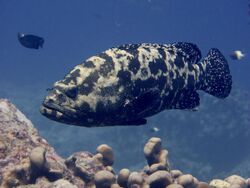Biology:Brown-marbled grouper
| Tiger grouper | |
|---|---|

| |
| Scientific classification | |
| Domain: | Eukaryota |
| Kingdom: | Animalia |
| Phylum: | Chordata |
| Class: | Actinopterygii |
| Order: | Perciformes |
| Family: | Serranidae |
| Subfamily: | Epinephelinae |
| Genus: | Epinephelus |
| Species: | E. fuscoguttatus
|
| Binomial name | |
| Epinephelus fuscoguttatus (Forsskål, 1775)
| |
| Synonyms[2] | |
| |
The brown-marbled grouper or tiger grouper (Epinephelus fuscoguttatus) is a benthic marine fish which belongs to the family Serranidae or also known as the groupers.
Description
Epinephelus fuscoguttatus is a medium-sized fish which grows up to 120 cm, but the average size mostly observed is 50 cm.[2] Its body has a stocky and robust aspect, is compressed laterally and has a sharp profile for the head. The mouth is big and has a superior position with many small teeth and canine in front. The background coloration is pale yellowish-brown with many dark brown or grey blotches that are irregular in size and shape. The body is also covered with many small dark brown spots. All the fins are large and round.
The brown-marbled grouper can be easily confused with its close relative Epinephelus polyphekadion. The differences are more obvious on adult specimens. The distinctive characters of the brown-marbled grouper are: a small black saddle on the top of caudal peduncle, when observed on the side a notch above the eyes and the front head is clearly visible, its body is quite thick from the front of the dorsal fin to the bottom of the fish below the pectoral fins.[3]
Distribution and habitat
It is widely distributed throughout the tropical and subtropical waters of the Indo-Pacific, from eastern coasts of Africa to the oceanic islands of the centre of the Pacific Ocean, Red Sea included. However, it is absent from the Persian Gulf, Hawaii and French Polynesia.[2]
Like many of the groupers, the brown-marbled grouper lives in rich clear waters close to coral or rocky reefs, lagoons and external slopes from the surface until 60 metres (200 ft) depth.[4]
Feeding
The brown-marbled grouper is carnivorous and its diet consists mainly in fishes, crustaceans and cephalopods. It is an ambush predator.[5]
Behavior
This grouper is solitary, sedentary, it defends a well defined territory, benthic and is nocturnal, with activity maximal at sunrise and/or at sunset.[6]
It has a quite long life span for a fish, it can expect to live until at least 40 years old.[7]
It is protogynous hermaphrodite, which means the female can evolve to male during its life.
Protection
The brown-marbled grouper is listed "Vulnerable" on the IUCN Red List of Threatened Species since 2004. Because of its size and hardiness, this species has a high commercial interest for the live food fish trade.
However, its biological characteristics make this species particularly vulnerable to over-fishing. Especially during mating periods at specific times and places, the brown-marbled grouper forms spawning aggregations which are easy and attractive targets for fishermen. The long life span of this grouper and its low population density in reefs in the wild result in a weak and slow population regeneration capacity. Furthermore, as fishers prefer to target large fish the brown-marbled groupers are a popular species. That concerns especially males so if the sex ratio between males and females is falling, it will affect the fertilization capacity of the species. It will have the same result on over-fishing females breeders that are highly fertile and would not be able to actively contributing to maintain the proportion of young in the population.
Brown-marbled groupers can be cultured by hatcheries but these installations' breeding stock are derived from wild caught fish. Wild capture of breeding stock also has a negative effect on the global population because all the groupers catch in any size category are kept and grown until they reach market size.
As ciguatera toxin is common in brown-marbled groupers' flesh, this does limit fishing of this species in some geographic areas.
Over the last few years, some protective measures or/and sustainable fishing methods have been introduced by many states where spawning aggregations are known, for example Indonesia, Papua New Guinea, Australia , Malaysia, Solomon Islands and Palau.[8][1]
References
- ↑ 1.0 1.1 Rhodes, K.; Sadovy, Y.; Samoilys, M. (2018). "Epinephelus fuscoguttatus". IUCN Red List of Threatened Species 2018: e.T44673A100468078. doi:10.2305/IUCN.UK.2018-2.RLTS.T44673A100468078.en. https://www.iucnredlist.org/species/44673/100468078. Retrieved 12 November 2021.
- ↑ 2.0 2.1 2.2 Froese, Rainer and Pauly, Daniel, eds. (2019). "Epinephelus fuscoguttatus" in FishBase. December 2019 version.
- ↑ Introduction to Monitoring and Management of Spawning Aggregations and Aggregation Sites for Three Indo-Pacific Grouper Species (Epinephelus fuscoguttatus, Epinephelus polyphekadion, and Plectropomus areolatus), THE NATURE CONSERVANCY, Indo-Pacific Draft Field Manual, June 2003, http://www.reefresilience.org/pdf/manual_field_practitioners.pdf
- ↑ Lieske, E. and R. Myers, 1994. Collins Pocket Guide. Coral reef fishes. Indo-Pacific & Caribbean including the Red Sea. Harper Collins Publishers, 400 p.
- ↑ Lieske & Myers,Coral reef fishes,Princeton University Press, 2009, ISBN:9780691089959
- ↑ Brulé & Déniel, ‘’ Expose synoptique des données biologiques sur le mérou rouge Epinephelus morio (valenciennes, 1828) du Golfe du Mexique’’, F.A.O., 1994,ISBN:9252034633
- ↑ Pears, R.J., J.H. Choat, B.D. Mapstone and G.A. Begg, 2006. Demography of a large grouper, Epinephelus fuscoguttatus, from Australia's Great barrier reef: implications for fishery management. Mar. Ecol. Prog. Ser. 307:259-272.
- ↑ "Facts about Brown-marbled Grouper (Epinephelus fuscoguttatus) - Encyclopedia of Life". http://eol.org/pages/209732/details#conservation.
External links
- http://www.fishbase.org/summary/4460
- Sugama, K, Rimmer, M, Ismi, S, Koesharyani, I, Suwirya, K, Giri, N.A, and Alava V.R. 2012. Hatchery management of tiger grouper (Epinephelus fuscoguttatus): a best-practice manual.
- Photos of Brown-marbled grouper on Sealife Collection
| Wikimedia Commons has media related to Brown-marbled grouper. |
Wikidata ☰ Q1239958 entry
 |


